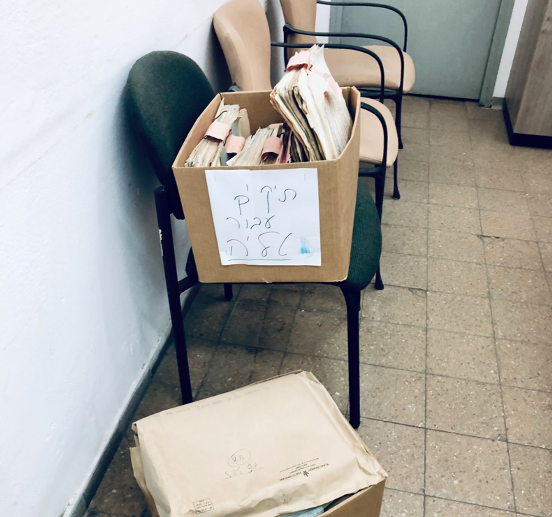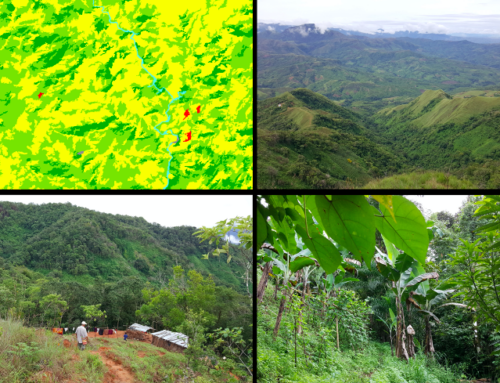This essay explores the texture of early Israeli clinical data on the Holocaust, generated between 1948 and the 1960s, to pose two questions. First, how does the clinician’s own intimacy with death shape knowledge production on catastrophic violence and subjectivity? Second, how might a return to the clinician’s details in the present moment provide us with an entry point for revisiting classical assumptions in trauma theory?
For 16 months, I collected writings of Hebrew-speaking clinicians, themselves displaced from Europe to Israel, who wrote about, treated, and interacted with survivors of the Holocaust in their everyday lives. To give some sense of this milieu, consider that between the years of 1948-1952, a Jewish population of around 650,000 absorbed more than 700,000 immigrants, roughly half of them estimated to be Holocaust survivors, though no such category yet existed (Davidovitch and Zalashik 2007). The survivor, then, was not only a bewildering clinical case, but a neighbor, a fellow woman giving birth in a public maternity ward (Palgi 1983), kin, or even the self (Körmendi 1990).

Behind the scenes at the Tel Aviv University Archive. Photo by author, Talia Katz.
I focus on the writings of one psychiatrist, Dr. Ruth Jaffe, who was a Professor of Psychiatry and Director of Shalvata Mental Health Hospital. Born in Berlin in 1907, Jaffe immigrated to Palestine in 1934. War and anti-Jewish violence dispersed her medical training across Germany, Switzerland, and Palestine. Engaging Jaffe’s movements of thought from 1963 to 1968, I explore her impulse to interpret traumatic memory through the categories of disassociation and “double consciousness”—as opposed to “hysteria” or “traumatic neurosis.” Her writing prefigures any general consensus on how to understand the impact of the Holocaust on the self in Israel.
For scholars of trauma in both clinical and non-clinical disciplines, reflecting on Jaffe’s distinctions offers important and underexplored insights not only on how violence marks the self, but also on how catastrophic violence leaves residues on the social and the world itself.
Jaffe first develops the idea of “double consciousness” in her paper, “Group Activity as a Defense Method in Concentration Camps” (1963), where she asks if a correlation can be established between her patient’s forced labor in Auschwitz death camp and a psychosis that sets in nine years post-liberation. Jaffe deploys the comparative method, juxtaposing two female patients, “M” and “P.” Both labor at Auchwitz, albeit under different conditions: M in a female unit akin to the sonderkommando, and P in a chemical production factory. Both endure the unendurable through a psychological defense mechanism that Jaffe terms “the realization of fantasy through group activity.” However, their stories diverge post-liberation as they establish new households in Israel. While P marries and seemingly establishes a meaningful new life, M’s efforts are punctured by two psychotic breaks. The second break never ends.1
True to her psychoanalytic orientation, Jaffe begins with the place of fantasy in M’s childhood. For financial reasons, M’s parents had sent her to live with her grandparents until the age of fourteen. Although her grandparents spoiled her, M felt a general malaise, and frequently daydreamed of a happy parental reunification. It was only upon the deportation of M’s entire town to Auschwitz that her fantasy takes on a decidedly pathological character, at least in Jaffe’s eyes.
On their first night in the death camp, an S.S. officer leads M and ten other young women who were also spared from immediate annihilation to their barracks. On the way, the young women come across “a large burning pool, into which uniformed men threw burning bodies” (236). The women refuse to move, shrieking and laughing and screaming that they, too, will be burned. The S.S. officer shouts, “We are living in the 20th century; in the 20th century people are not being burned,” and then drove them on with a stick (236). We learn that by the next morning, the pool was surrounded by electric fence such that the girls could not confirm the reality of their terrifying observations. For M, “the doubt remained with her and marked the beginning of a pathological change in herself, which she described as a feeling of unreality and a growing mistrust of her faculty to judge reality” (236).
Importantly, Jaffe does not interpret this experience as a traumatic event. Rather, she constitutes it as the threshold through which the madness of living within a killing machine gives way to a new structure of social life and consciousness. M and the women in her group begin to live among death. On a daily basis, they uncover the murder of more and more kin. They sort the jewelry and photographs of the deceased. They watch columns of people who never return. While doing this, the women organize themselves into a “holy order,” forming a tribunal with a moral code, where they comfort one another, engage in acts of sabotage, and share daydreams. Jaffe argues that the women found a “defense” in the protective dimension of group identification, for it allowed them to cultivate dignity and resistance, and to shelter against isolation and fear, if only temporarily.
Upon liberation, the feeling of unreality never leaves M. Jaffe suggests that M’s feelings of belonging within her group were particularly charged because of her lingering childhood feelings of separation. Indeed, M felt deep loneliness and disappointment seeing her group of girls disband into “private ambition,” which she understood as the desire to marry, find refuge, and build a family (237). Her feelings of disappointment and frustration in her own marriage led her straight into daydreaming of her group activity at Auschwitz. Jaffe insists this is not a disassociation of emotion, but rather a “clothing of reality in [M’s] own concepts (239).” That is to say, to simply speak of M’s mental state as hazy, dulled, or indifferent is inadequate for Jaffe. Instead, she employs the concept of “double consciousness” to articulate how M’s experience of everyday life in Israel is stitched with her death camp reality through everyday sensory experiences and objects (e.g. the smell of smoke). It is interesting to consider how Jaffe locates this experience within individual psychology (labeled “double consciousness”), whereas Veena Das (2022) might ask us to consider how contexts register onto objects.2 The crux of the difference here is a picture of the relationship between words and world, and this difference is of consequence when we then think of how each author arrives at a formulation of what constitutes the subject’s interiority. Anthropology methods thus offer a potent critique of the individual psychological subject, showing how inner and outer might be knitted together through life lived in language.
Rather than evaluate Jaffe’s comparative method or her project to establish correlation between imprisonment in a death camp and psychosis later in life, I want to ask: What we might learn from a re-engagement with Jaffe’s clinical data? Even if we are at the disadvantage of only having Jaffe’s voiceover through which to learn about these young women’s lives, in the details provided, we may find shadows of access to the “fragments of subjective experience” of M and P (Rechtman 2017).
Jaffe’s clinical vignettes consolidate haunting scenes of social life within a death machine into the “defense mechanism of group activity.” However, I believe it is also possible to read her data slightly otherwise. Couldn’t we let the description of M’s first night at Auschwitz, which was her entrance into a world of death, actually undo Jaffe’s articulation of a sharp distinction between the real and fantasy? Indeed, taking seriously what constitutes the “real” within a form of death may force us to think quite differently about what constitutes the ordinary under conditions of catastrophic violence. Re-reading clinical data with an ethnographic eye shows that the experience of violence is not interior and individually determined, but relational. The catastrophic violence of Nazi genocide manifests in an all-encompassing entanglement of the natural and the social, a collaboration that cannot be reduced to individual psychopathology. As M’s case study reveals, fire, friendship, and public health transfigure as concepts and objects in the world. The temporality of this transfiguration lasts well beyond the period of internment. This is the difficulty of reality.
In his work with survivors of the Cambodian genocide, Richard Rechtman (2006, 3) writes that “it is not always the empirical event that is responsible for the traumatic effect, especially in political violence and mass extermination.” Rechtman’s concern has focused on how the perpetrator’s rhetoric retains his patients in a world of death. While my work similarly expresses a skepticism around centering the “traumatic event” and the temporalities it assumes, my attention to Jaffe’s formulation of “double consciousness” leads me to critique the notion of event from a different angle. Studying how: 1) the real and the fantastic hook into one another, and 2) catastrophic violence leaves residues on the material world thus offers an important way to re-approach what it is to retain an enduring belonging to a form of death.
Notes
[1] While Jaffe does not directly comment on these different outcomes, her lingering on M’s childhood biography suggests there is something important for her about the relationship between childhood psychic conflicts and external traumata experienced later in life. By 1968, Jaffe clarifies this initial interest with the following formulation: “But infantile conflicts are ubiquitous, and it is presumed here that no psychic illness need have occurred without the subsequent massive traumatization. Freud’s concept of the complementary series should be remembered in this context according to which subsequent traumata are capable of heavily outweighing adverse constitutional and infantile factors” (312).
[2] See Das’ extended description of the rubber belt (patta) within the scene of torture, bringing her to the following formulation: “the use of everyday objects extends the scene of torture even when the accused has been released because he cannot obliterate these objects from his everyday life, nor can he simply live with the betrayals that he cannot easily forget. This is the difficulty of reality where the nature of bitter compromises poses problems for thought, but much more for the very project of bringing life back into the living” (2022, 64-65).
Acknowledgements
My gratitude goes to Ella Meirson and Gedalya Zhagov of the Tel Aviv University Archive for their archival research support. I would not have come into the above documents without their meticulous labor. I thank Clara Han, Naveeda Khan, and the AES Editorial Team for their generous feedback on earlier versions of this essay. Lastly, thank you to Mima, for bequeathing to me the importance of these questions.
References
Das, Veena. 2022. Slum Acts. Cambridge: Polity Press.
Davidovitch, Nadav, and Rakefet Zalashik. 2007. “Recalling the Survivors: Between Memory and Forgetfulness of Hospitalized Holocaust Survivors in Israel.” Israel Studies 12(2): 145–63.
Jaffe, Ruth. 1963. “Group Activity as a Defense Method in Concentration Camps.” The Israeli Annals of Psychiatry and Related Disciplines 1(2): 235–43.
———. 1968. “Dissociative Phenomena in Former Concentration Camp Inmates: Contribution to Symposium on Psychic Traumatization through Social Catastrophe.” The International Journal of Psychoanalysis 49: 310.
Körmendi, Balázs. 1990. Zsidó Gyónás. Budapest: Interart Stúdió.
Palgi, Phyllis. 1983. “Reflections on Some Creative Modes of Confrontation With the Phenomenon of Death.” International Journal of Social Psychiatry 29(1): 29–37
Rechtman, Richard. 2006. “The Survivor’s Paradox: Psychological Consequences of the Khmer Rouge Rhetoric of Extermination.” Anthropology & Medicine 13(1): 1–11.
———. 2017. “From an ethnography of the everyday to writing echoes of suffering.” MAT Medicine Anthropology Theory 4(3): 130.
Talia Katz is a PhD Candidate in Anthropology at Johns Hopkins University. Her research explores the intersections of theatre and psychiatry, charting how Israeli psychiatry experiments with aesthetic forms under the pressures of catastrophic violence, war, and displacement. Her research has been generously supported by the Wenner-Gren Foundation, the US Department of Education’s Foreign Language Area Studies Grant (FLAS), the Society for Psychological Anthropology, and the American Ethnological Society.
Cite As: Katz, Talia. 2023. “Between Fantasy and the Difficulty of Reality in Israeli Psychiatry” In “data/Big Data in the field” edited by Naveeda Khan, American Ethnologist website, December 22 2023, [https://americanethnologist.org/data-big-data-in-the-field/between-fantasy-and-the-difficulty-of-reality/]




